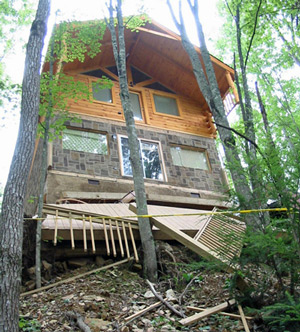
Picture From The Home Doctor
Nevada County is beautiful, scenic and in many areas serene. Most homes in Nevada County have decks—so folks can enjoy the views, sun and solitude. Nevada County also enjoys autumn and winter-rains and a few days of snow. Due to the four seasons, decks and structural members are exposed to elements year-round, and lack of maintenance can make decks unsafe.
Decks built without permits that are constructed incorrectly, or have inadequate structural members, make these decks unreliable and often dangerous. Failure in building construction may not be immediate. Sometimes deterioration can take place many years after construction.
Decks are wonderful places to celebrate life and have friends and family over for all types of festive occasions. However, decks, like your house, must be designed to support the weight of people and furniture. In addition, decks have to support the weight of snow in the winter and resist wind and earthquakes. Understanding how forces work on your deck and how these forces effect the safety of your deck is important. There are typically three forces that interact with decks: gravity, lateral, and uplift.
- Gravity
Gravity is the downward force that originates when people, furniture, barbeques, snow and ice are on a deck.
- Lateral
Lateral motion is the back and forth movement usually caused by people walking on the deck or leaning on the rails. This motion can also be caused by earthquakes.
- Uplift
Uplift is caused when storms bring winds. This wind flows under the deck and creates an uplifting effect. In addition, standing on the overhand portion of the deck creates an upward pressure on the connections holding the deck to the house.
Most experts agree that the average life of a deck is ten to 15 years. Many homes in Nevada County are older and could have broken-down decks that can fail. It is important to check your deck for signs of deterioration and to check the condition of the structural members such as beams, posts, and deck joints.
Let’s look at some warning signs:
- Missing Connections: A deck is usually built with wood, nail, metal connectors and screws. Observe how your deck is built. If all you see are nail then your deck may be unsafe.
- Loose Connections: Are your handrails loose? Does your guardrail move more than a little when your push it? If so, you probably have loose or no connections.
- Corrosion of Connectors and Fasteners: Over time, metal corrodes. Look for rust and other signs of corrosion. If you see a white powdery substance on metal hangers, it is a sign of corrosion.
- Rot: Wood can rot and deteriorate over time. Look for signs of rot. Rotted members may no longer be able to support the weight it once did when the deck was new. Having a few extra folks on the deck may cause these rotted members to fail.
- Cracks: As wood gets old, it develops cracks. Large cracks or excessive cracking can overall weaken your deck.
If you notice any of these warning signs, please contact a professional contractor or engineer to review your findings to determine what action may be needed.
Source: Written by Brian Washko, Chief Building Inspector for Nevada County, M.P.C